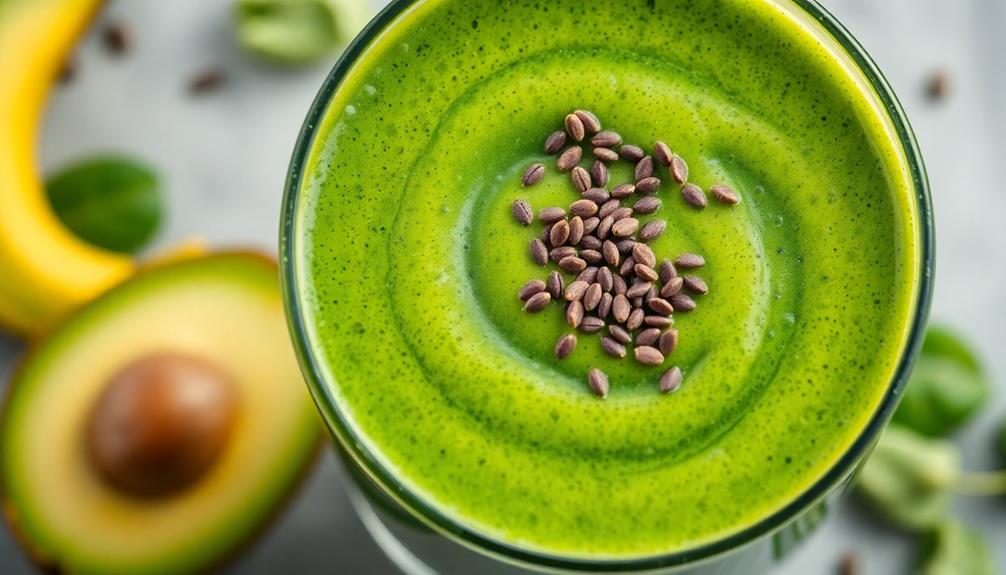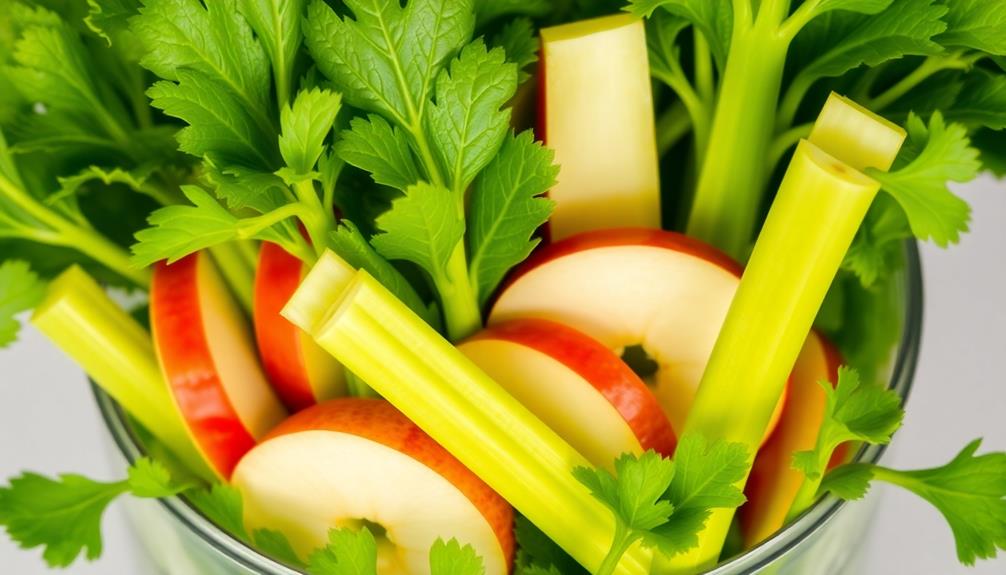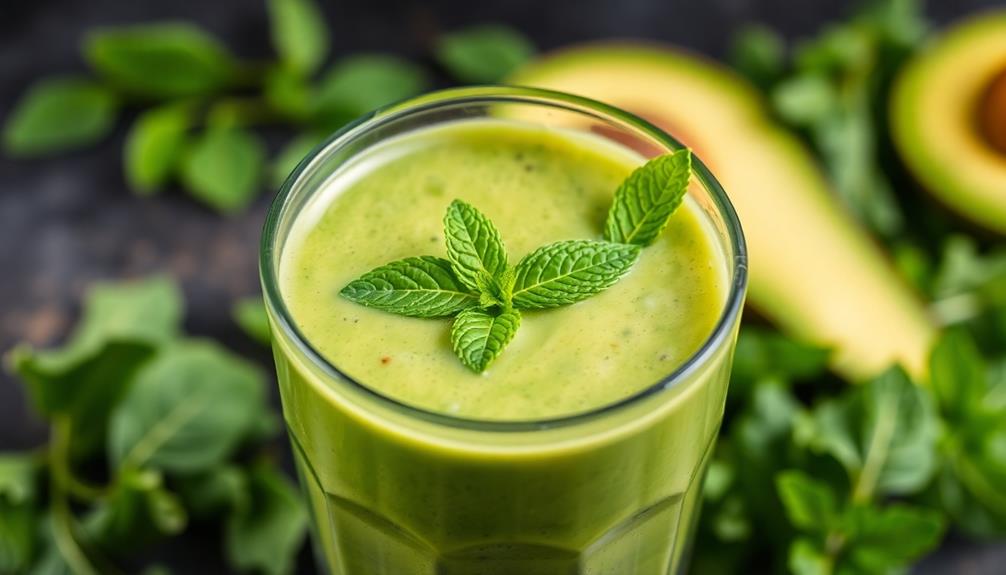Dive into the rich history and vibrant traditions of raw hot chocolate, a captivating connection to the ancient Mesoamerican cultures that first revered this restorative elixir. Made with raw cacao powder, creamy nut milk, and natural sweeteners, this indulgent beverage packs a nutritional punch, bursting with antioxidants and essential minerals. Crafting your own raw hot chocolate is a delightful ritual, allowing you to customize flavors and garnishes. Sip on this comforting treat and discover how it can promote a sense of well-being, all while tantalizing your taste buds. There's so much more to explore about this ancient delight.
Key Takeaways
- Raw hot chocolate is rooted in ancient Mesoamerican cultures, where cacao beans were valued for their health benefits and used in sacred rituals.
- The recipe features raw cacao powder, unsweetened almond milk, and natural sweeteners like honey or maple syrup, providing a nutrient-rich and guilt-free indulgence.
- Consuming raw hot chocolate offers numerous health benefits, including antioxidant support, mineral replenishment, and sustained energy without the crash of refined sugars.
- The preparation of raw hot chocolate can be a mindful self-care ritual, fostering relaxation and a sense of well-being through the creamy, spiced, and indulgent experience.
- Raw hot chocolate is a versatile beverage that can be customized with various toppings, milk alternatives, and seasonal ingredients, allowing for continuous exploration and experimentation.
History

Raw hot chocolate has a rich and storied history, with origins dating back centuries. You might be surprised to learn that this delightful drink first emerged in ancient Mesoamerican civilizations, where the cacao bean was highly prized and used in sacred rituals. The Olmecs, Mayans, and Aztecs all played a role in cultivating and revering this magical ingredient.
The use of cacao in these cultures wasn't only for its flavor but also for its health benefits that align with today's focus on nutritious foods.
As European explorers ventured into the Americas, they discovered the wonders of chocolate and brought it back to the Old World. Over time, the recipe evolved, with the addition of milk, sugar, and other spices. By the 17th century, hot chocolate had become a beloved treat among the European elite, sipped in high-society salons and royal courts.
Today, raw hot chocolate continues to captivate our taste buds, offering a delicious and nutritious way to savor the rich history of this ancient elixir. With each sip, you can connect to the vibrant cultures that first celebrated the power of the cacao bean.
Recipe
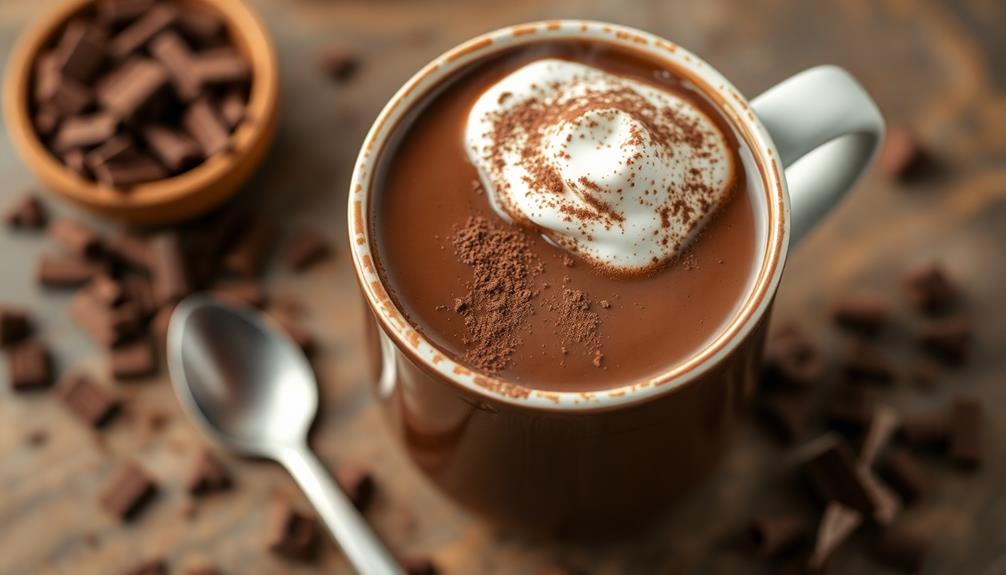
Raw hot chocolate is a delightful and nourishing treat that can be enjoyed year-round. Unlike traditional hot chocolate, this version is made with raw, unprocessed ingredients, which preserves the natural vitamins, minerals, and antioxidants. The result is a rich, creamy, and deeply chocolatey beverage that's both satisfying and good for you.
Additionally, the use of wholesome ingredients can contribute to overall health, much like the benefits of celery juice and pregnancy, which emphasizes the importance of nutrient-rich beverages.
One of the key ingredients in raw hot chocolate is raw cacao powder, which is the purest form of chocolate available. It's packed with flavonoids, magnesium, and other beneficial compounds that support overall health and well-being.
Additionally, this recipe utilizes natural sweeteners like raw honey or maple syrup, which add depth of flavor without the refined sugar found in many commercial hot chocolate mixes.
- 2 cups unsweetened almond milk
- 2 tablespoons raw cacao powder
- 2 tablespoons raw honey or maple syrup
- 1 teaspoon vanilla extract
- Pinch of sea salt
In a small saucepan, whisk together the almond milk, cacao powder, honey or maple syrup, vanilla, and sea salt. Heat the mixture over medium-low heat, stirring frequently, until it's warmed through and the ingredients are fully incorporated, about 5 minutes.
Be careful not to boil the mixture, as this can cause the raw cacao to lose some of its beneficial properties.
To enhance the richness and creaminess of the raw hot chocolate, consider adding a tablespoon of raw coconut oil or a sprinkle of cinnamon. You can also experiment with different nut milks or toppings, such as toasted coconut flakes or a dollop of whipped cream.
Enjoy this nourishing and indulgent treat on a cozy evening or as a mid-afternoon pick-me-up.
Cooking Steps
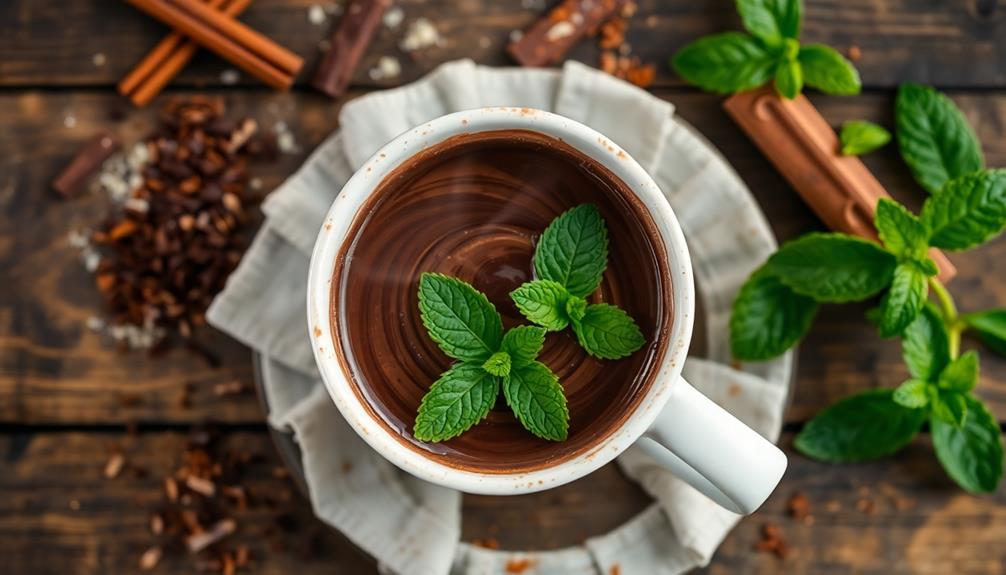
Alright, let's get started on those raw hot chocolate cooking steps!
First, you'll want to add the raw cacao powder and whisk it right into some nice, creamy grass-fed milk.
For an extra boost of flavor, consider pairing your hot chocolate with a side of health benefits of ginger lemon tea to enhance your cozy experience.
Then, sweeten it up with your favorite sweetener to get that rich, chocolatey flavor just the way you like it.
Finally, top it off with a sprinkle of cinnamon and some fluffy marshmallows for the perfect cozy, comforting treat.
Enjoy your homemade raw hot chocolate!
Step 1. Add Raw Cacao Powder

Once you've gathered your ingredients, it's time to add the raw cacao powder. This is the secret ingredient that gives your raw hot chocolate its deep, rich, chocolatey flavor! Carefully measure out 2 tablespoons of raw cacao powder and add it to your blender or food processor.
The raw cacao powder is packed with antioxidants and minerals, so it's not only delicious, but also super healthy.
Next, give everything a good blend until the cacao powder is fully incorporated. You'll know it's ready when the mixture looks smooth and creamy.
Don't be afraid to blend for a little extra time to make sure there are no lumps or chunks. The better you blend, the silkier your raw hot chocolate will turn out.
Step 2. Whisk in Grass-Fed Milk

With your raw cacao powder now blended in, it's time to whisk in the grass-fed milk. This rich, creamy liquid will bring the whole hot chocolate together, making it even more delicious.
Grab your whisk and get ready to stir! Gently pour the milk into the bowl, making sure to incorporate it evenly. Don't be afraid to put some elbow grease into it – you want the mixture to be smooth and lump-free.
The grass-fed milk will add a lovely creaminess and slight sweetness that balances out the intense cocoa flavor. Keep whisking until everything is well combined and the texture is silky.
Now your raw hot chocolate is really taking shape! You're just a few steps away from sipping this rich, decadent treat. Stay focused and keep that whisk moving – you've got this!
Step 3. Add Sweetener to Taste

Now that you've got that creamy, dreamy milk whisked in, it's time to add a touch of sweetener to taste.
This is where you can really make the raw hot chocolate your own! You might like to use a bit of honey or maple syrup to give it a lovely, natural sweetness.
Start with just a teaspoon and give it a taste. If you'd like it a bit sweeter, add another half-teaspoon.
Keep tasting and adjusting until it's exactly how you love it. The great thing about making your own raw hot chocolate is you get to control the sweetness level.
Some folks prefer it on the richer, less sweet side, while others like it nice and sweet.
It's all about your personal preference. Go ahead, give it a taste and see what you think!
Just remember, you can always add more sweetener, but it's harder to undo if you add too much.
Step 4. Garnish With Cinnamon and Marshmallows
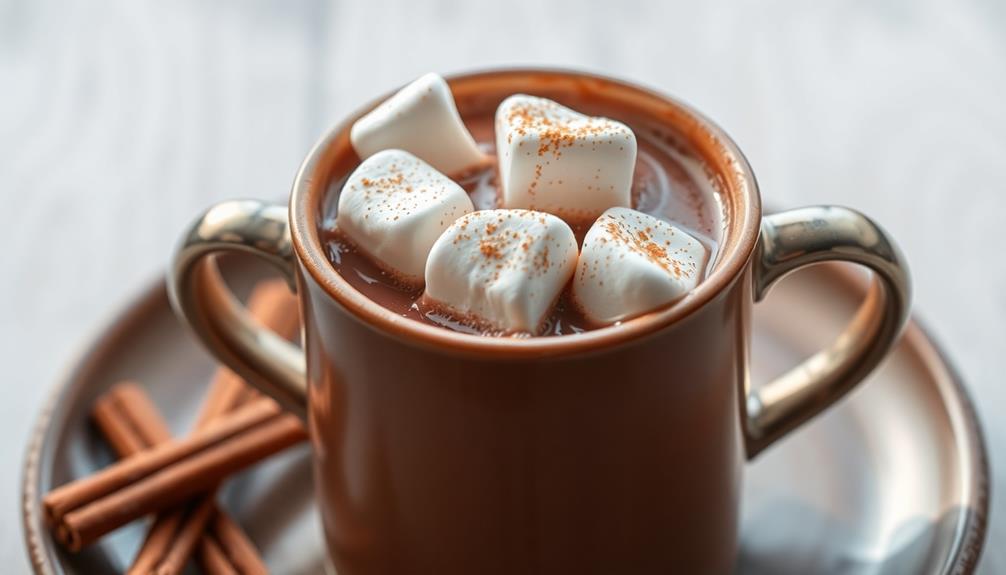
Top your raw hot chocolate with a sprinkle of ground cinnamon for a touch of warmth and spice. The cinnamon's fragrant aroma and slightly sweet flavor will dance on your tongue, elevating the rich, creamy goodness of your homemade treat.
Don't be shy – add a generous dusting to really bring out the cinnamon's full potential!
For an extra indulgent experience, top your hot chocolate with fluffy, soft marshmallows. These sweet, pillowy morsels will melt into the steaming liquid, creating pockets of gooey deliciousness.
Watch as they slowly dissolve, blending seamlessly with the cocoa. The contrast of the smooth chocolate and the pillowy marshmallow is simply heavenly.
Garnishing your raw hot chocolate with cinnamon and marshmallows is the perfect way to make this cozy beverage even more special.
The combination of flavors and textures will delight your senses and leave you feeling warm and satisfied. Sip, savor, and enjoy your perfectly dressed up raw hot chocolate!
Step 5. Enjoy Your Raw Hot Chocolate

Indulge in the velvety richness of your homemade raw hot chocolate. Take your time and savor each sip, letting the smooth, creamy goodness melt on your tongue. This decadent treat is a true delight for the senses.
Start by carefully pouring your raw hot chocolate into your favorite mug. Gently top it with a dollop of whipped cream or a few mini marshmallows for an extra special touch. If you're feeling adventurous, sprinkle a pinch of cinnamon or a dusting of cocoa powder on top.
As you take your first sip, notice the depth of flavor and the warm, comforting sensation it provides. The raw cacao and creamy coconut milk blend together seamlessly, creating a luxurious experience that's sure to satisfy your sweet tooth.
Savor each moment, and don't be afraid to indulge in a second or even a third cup – this raw hot chocolate is that good!
Final Thoughts

As you've explored the delightful world of raw hot chocolate, you've likely discovered the richness and depth of flavor that this beverage offers. The natural sweetness and creaminess of raw cacao, combined with the warming spices, create a truly unique and satisfying experience.
You may have even found ways to personalize your raw hot chocolate, adding your favorite toppings or experimenting with different milk alternatives.
Looking ahead, you can continue to enjoy the benefits of raw hot chocolate. Not only is it a delicious treat, but it's also a healthier option compared to traditional hot chocolate mixes. The unprocessed cacao and lack of added sugars make it a more nutritious choice.
Plus, the ritual of preparing and sipping on a warm mug of raw hot chocolate can be a moment of self-care and mindfulness in your day.
As you move forward, embrace the versatility of raw hot chocolate and find new ways to savor its rich, comforting flavors. Experiment with different spice blends, try pairing it with seasonal ingredients, or share the joy of raw hot chocolate with friends and family.
The possibilities are endless, so dive in and keep exploring this delightful and beneficial beverage.
Frequently Asked Questions
How Long Does Raw Hot Chocolate Last?
Unopened, it can last around 1-2 years. Once opened, it's best consumed within 6-12 months for optimal freshness and flavor. Store it in an airtight container in a cool, dry place to extend its shelf life.
Can I Make Raw Hot Chocolate in Advance?
You can make raw hot chocolate in advance, but it's best consumed within a few days for optimal freshness and flavor. Store it in an airtight container in the fridge, and give it a good stir before serving.
Is Raw Hot Chocolate Suitable for Vegans?
Yes, raw hot chocolate can be suitable for vegans. As long as you use plant-based milk and dairy-free chocolate, you can enjoy a delicious vegan hot chocolate. Just be sure to check the ingredients carefully.
How Does Raw Hot Chocolate Differ From Traditional Hot Chocolate?
Traditional hot chocolate usually contains milk and other dairy ingredients, while raw hot chocolate is dairy-free, using just cocoa powder, sweetener, and plant-based milk alternatives. This makes raw hot chocolate a more suitable option for vegans compared to the traditional version.
Can I Use Any Type of Cacao Powder for Raw Hot Chocolate?
You can use any type of cacao powder for raw hot chocolate. However, raw cacao powder will provide more health benefits and a richer, more intense chocolate flavor compared to regular cocoa powder.




